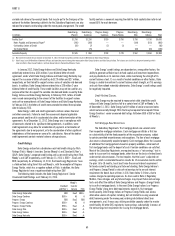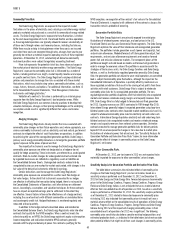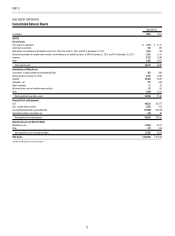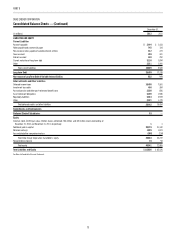Duke Energy 2012 Annual Report Download - page 86
Download and view the complete annual report
Please find page 86 of the 2012 Duke Energy annual report below. You can navigate through the pages in the report by either clicking on the pages listed below, or by using the keyword search tool below to find specific information within the annual report.
66
PART II
Energy Carolinas’ and Progress Energy Florida’s rates; therefore, fl uctuations
in equity prices do not affect their Consolidated Statements of Operations
as changes in the fair value of these investments are deferred as regulatory
assets or regulatory liabilities pursuant to an Order by the NCUC, PSCSC and
FPSC. Earnings or losses of the fund will ultimately impact the amount of
costs recovered through Duke Energy Carolinas’, Progress Energy Carolinas’
and Progress Energy Florida’s rates. See Note 9 to the Consolidated Financial
Statements, “Asset Retirement Obligations” for additional information regarding
nuclear decommissioning costs. See Note 17 to the Consolidated Financial
Statements, “Investments in Debt and Equity Securities” for additional
information regarding NTDF assets.
Foreign Currency Risk
Duke Energy is exposed to foreign currency risk from investments in
international businesses owned and operated in foreign countries and from
certain commodity-related transactions within domestic operations that are
denominated in foreign currencies. To mitigate risks associated with foreign
currency fl uctuations, contracts may be denominated in or indexed to the
U.S. Dollar/infl ation rates and/or local infl ation rates, or investments may be
naturally hedged through debt denominated or issued in the foreign currency.
Duke Energy may also use foreign currency derivatives, where possible, to
manage its risk related to foreign currency fl uctuations. To monitor its currency
exchange rate risks, Duke Energy uses sensitivity analysis, which measures the
impact of devaluation of the foreign currencies to which it has exposure.
In 2012, Duke Energy’s primary foreign currency rate exposure was to
the Brazilian Real. The table below summarizes the potential effect of foreign
currency devaluations on Duke Energy’s Consolidated Statement of Operations
and Consolidated Balance Sheets, based on a sensitivity analysis performed as
of December 31, 2012 and December 31, 2011.
Summary of Sensitivity Analysis for Foreign Currency Risks
(in millions)
Assuming 10% devaluation in the currency
exchange rates in all exposure currencies
As of December 31,
2012
As of December 31,
2011
Income Statement impact(a) $ (20) $ (20)
Balance Sheet impact(b) $(150) $(160)
(a) Amounts represent the potential annual net pre-tax loss on the translation of local currency earnings to
the Consolidated Statement of Operations in 2012 and 2011, respectively.
(b) Amounts represent the potential impact to the currency translation through the cumulative translation
adjustment in Accumulated Other Comprehensive Income (AOCI) on the Consolidated Balance Sheets.
Other Issues
Fixed Charges Coverage Ratios
The Duke Energy Registrants’ fi xed charges coverage ratios, as calculated
using SEC guidelines, are included in the table below.
Years Ended December 31,
2012 2011 2010
Duke Energy 2.5
(a) 3.2 3.0
Duke Energy Carolinas 3.7 3.7 3.6
Progress Energy 1.6 2.1 2.6
Progress Energy Carolinas 2.2 4.2 5.1
Progress Energy Florida 2.3 2.8 3.4
Duke Energy Ohio 3.4 3.4 (b)
Duke Energy Indiana 0.1 2.2 3.6
(a) Includes the results of Progress Energy, Inc. beginning on July 2, 2012.
(b) Duke Energy Ohio’s earnings were insuffi cient to cover fi xed charges by $317 million in 2010 due
primarily to non-cash goodwill and other asset impairment charges of $677 million in 2010.
Global Climate Change
The EPA publishes an inventory of man-made U.S. greenhouse gas (GHG)
emissions annually. In 2010, the most recent year reported, carbon dioxide
(CO2), a byproduct of all sources of combustion, accounted for approximately
84 percent of total U.S. GHG emissions. The Duke Energy Registrants’ GHG
emissions consist primarily of CO2 and most come from its fl eet of coal-fi red
power plants in the U.S. In 2012, the Duke Energy Registrants’ U.S. power plants
emitted approximately 132 million tons of CO2. The CO2 emissions from Duke
Energy’s international electric operations were approximately 3 million tons. The
Duke Energy Registrants’ future CO2 emissions will be infl uenced by variables
including new regulations, economic conditions that affect electricity demand,
and the Duke Energy Registrants’ decisions regarding generation technologies
deployed to meet customer electricity needs.
The Duke Energy Registrants believe it is unlikely that legislation
mandating reductions in GHG emissions or establishing a carbon tax will be
passed by the 113th Congress which began on January 3, 2013. Beyond 2014
the prospects for enactment of any federal legislation mandating reductions
in GHG emissions or establishing a carbon tax is highly uncertain. Given the
high degree of uncertainty surrounding potential future federal GHG legislation,
management cannot predict if or when such legislation might be enacted, what
the requirements of any potential legislation might be, or the potential impact
it might have on the Duke Energy Registrants. Among the outcomes of the
18th Conference of the Parties of the United Nations Framework Convention
on Climate Change which concluded in December 2012 was an affi rmation by
the participating countries to complete negotiations on a new global agreement
by 2015 that would take effect in 2020. The international climate change
negotiating process is highly uncertain and management cannot predict what
the outcome might be or the potential impact it might have on the Duke Energy
Registrants.
The Duke Energy Registrants do not anticipate any of the states in which
it currently operates fossil-fueled electric generating units taking action absent
a federal requirement to mandate reductions in GHG emissions from these
facilities.
The Duke Energy Registrants are taking actions today that will result in
reduced GHG emissions over time. These actions will lower the Duke Energy
Registrants’ exposure to any future mandatory GHG emission reduction
requirements or carbon tax, whether a result of federal legislation or EPA
regulation. Under any future scenario involving mandatory GHG limitations, the
Duke Energy Registrants would plan to seek recovery of their compliance costs
through appropriate regulatory mechanisms.
The Duke Energy Registrants recognize that certain groups associate
severe weather events with climate change, and forecast the possibility
that these weather events could have a material impact on future results
of operations should they occur more frequently and with greater severity.
However, the uncertain nature of potential changes of extreme weather events
(such as increased frequency, duration, and severity), the long period of time
over which any potential changes might take place, and the inability to predict
these with any degree of accuracy, make estimating any potential future
fi nancial risk to the Duke Energy Registrants’ operations that may result from
the physical risks of potential changes in the frequency and/or severity of
extreme weather events, whatever the cause or causes might be, impossible.
Currently, the Duke Energy Registrants plan and prepare for extreme weather
events that it experiences from time to time, such as ice storms, tornados,
hurricanes, severe thunderstorms, high winds and droughts.
The Duke Energy Registrants’ past experiences preparing for and
responding to the impacts of these types of weather-related events would
reasonably be expected to help management plan and prepare for future severe
weather events to reduce, but not eliminate, the operational, economic and
fi nancial impacts of such events. For example, the Duke Energy Registrants
routinely take steps to reduce the potential impact of severe weather events
on its electric distribution systems. The Duke Energy Registrants’ electric
generating facilities are designed to withstand extreme weather events without
signifi cant damage. The Duke Energy Registrants maintain an inventory of coal
and oil on site to mitigate the effects of any potential short-term disruption in
























